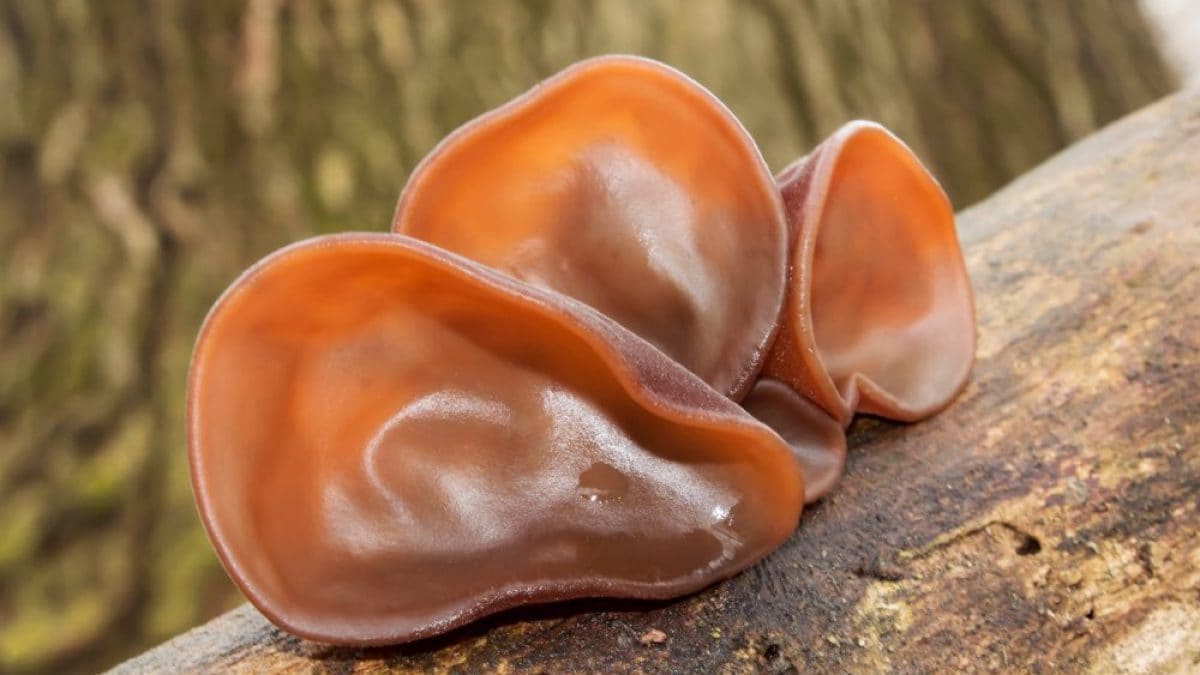
A mushroom with a unique shape resembling a human ear, Auricularia auricula-judae, commonly known as Judas' ear, boasts remarkable properties as well as a distinctive flavor. Not as well known as its "cousins" the oyster mushroom, chanterelle mushroom, or button mushroom, it grows primarily on deadwood, especially elderberry trunks, but can also be found on other broadleaf trees. Here's everything you need to know about Judas' ear: where to find it, how to care for it, and most importantly, how to use it in the kitchen.
What Does Judas' Ear Look Like and Where Can You Find It?
As its name suggests, it has a very distinctive shape, resembling a human ear. The fruiting body is cartilaginous, gelatinous, and can reach considerable size. Its color can vary from dark brown to reddish, depending on humidity and ripeness. The outer surface is slightly hairy, while the inner surface is smooth and veined. The name "Judas ear" comes from a legend according to which Judas Iscariot hanged himself from an elderberry tree, and this mushroom grew at the very site of his death. It seems that in the past, it was used as a hemostatic to stop small hemorrhages.
It grows mainly on deadwood, especially elderberry trunks, but can also be found on other broadleaf trees such as beech, maples, and black locust. It prefers temperate, humid climates. It is particularly widespread in Europe, especially in deciduous forests, where it prefers dead elderberry wood. In Asia, especially in China, Japan, and Korea, it is highly prized and cultivated on a large scale. It is also found in some regions of North America, especially in temperate forests.

How to Collect Judas' Ear
Judas ear is found mainly in autumn and winter, but can be harvested year-round if the weather conditions are favorable. Some small tips on harvesting:
- Be sure to collect only healthy, well-identified specimens. If you're unsure, it's best to leave it alone.
- Use a sharp knife to cut the mushroom at the base.
- Place the mushroom in a basket and not in a closed bag, so that it can release its spores naturally.
You can also buy cultivated specimens, so you can be more sure.
Judas' Ear's Benefits
Judas ear is a mushroom with numerous beneficial properties, prized both in cooking and in traditional medicine. Here are some of its best-known benefits:
- Fiber. Judas ear is an excellent source of dietary fiber, essential for proper intestinal function. It helps regulate intestinal transit and promotes a feeling of satiety.
- Antioxidant properties. It contains several antioxidant compounds that help fight free radicals, protecting cells from oxidative damage and helping prevent premature aging and some chronic diseases.
- Cardiovascular benefits. Judas ear is believed to help reduce the risk of cardiovascular disease, thanks to its ability to lower blood cholesterol levels and improve circulation. Some studies suggest that this mushroom may have anticoagulant properties, helping prevent blood clots and reducing the risk of cardiovascular disease.
- Anti-inflammatory properties. Judas ear has anti-inflammatory properties that can be useful in alleviating the symptoms of some inflammatory diseases.
- Source of vitamins and minerals. Although in smaller quantities than other foods, Judas ear contains some B vitamins and minerals such as iron.

Contraindications
Although generally considered safe for consumption, wood ear, like all mushrooms, has some precautions. Excessive consumption or mushrooms harvested in polluted environments can lead to the accumulation of mycotoxins, substances potentially harmful to the body. As mentioned, wood ear has anticoagulant properties, so its consumption is not recommended for those with bleeding disorders or those taking anticoagulant medications. Excessive and prolonged consumption can lead to Szechwan syndrome, a condition characterized by blood clotting disorders. Therefore, avoid consuming it before surgery, and if you suffer from hemophilia or other bleeding disorders, consult your doctor before consuming it.
Like all mushrooms, it can cause allergic reactions in susceptible individuals. There are no specific studies on the effects of eating wood ear during pregnancy and breastfeeding, so it is advisable to avoid excessive consumption during these periods.
How to Treat Judas' Ear
Before discussing recipes, it's important to explain how to treat Judas ear. Follow these steps:
- Cleaning: Remove any soil or wood residue with a soft brush.
- Soaking if necessary. Soak the mushrooms in warm water for about 30 minutes to remove any impurities.
- Cooking. It is not necessary to boil them before cooking.
- Rehydration in water. If you purchase dried Judas ear, you'll need to rehydrate it in warm water for at least 30 minutes before using it.

How to Cook Judas' Ear
The wood ear mushroom is a very versatile mushroom and can be used in a variety of preparations: it has a delicate flavor and a crunchy texture that pairs well with many other ingredients. It is widely used in Chinese, Japanese, and Korean cuisine, where it is added to soups, stews, and stir-fries.

It cooks very quickly, so simply sauté it in a pan with a little oil, garlic, and chili pepper for a few minutes: avoid cooking it too long, otherwise it will become rubbery. Judas ear is perfect for enriching miso soups, vegetable soups, or vegetable broths. You can sauté it with vegetables, tofu, or meat, making it a delicious and nutritious side dish. Added to a risotto, it gives an oriental touch and a unique texture. It can be used to season noodles, along with vegetables, soy sauce, and sesame. Rehydrated and sliced Judas ear can be added to mixed salads, along with fresh vegetables and a light dressing.
;Resize,width=767;)
